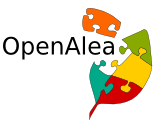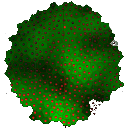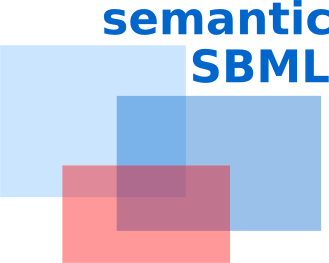Software description

BiNoM is a Cytoscape plugin, developed to facilitate the manipulation of biological networks represented in standard systems biology formats (SBML, SBGN, BioPAX) and to carry out studies on the network structure. BiNoM provides the user with a complete interface for the analysis of biological networks in Cytoscape environment.

BioModels Database is a data resource that store published mathematical models of biological interest. Models are annotated and linked to relevant data resources, such as publications, databases of compounds and pathways, controlled vocabularies, etc.
On SB.OS, you find the models in the directory /opt/Models/BioModels/curated.

BioNetGen is software for the specification and simulation of rule-based models of biochemical systems, including signal transduction, metabolic, and genetic regulatory networks.The BioNetGen language has recently been extended to include explicit representation of compartments.
BooleanNet
The goal of BooleanNet is to provide intuitive and accessible tools for simulating biological regulatory networks in a boolean formalism. Using this simulator biologist and bioinformaticians can specify their system in a simple textual language then explore various dynamic behaviors via a web interface or an application programming interface (API) each designed to facilitate scientific discovery, data collection and reporting.
The software is primarly distributed as Python source code and requires that Python 2.5 (or later) be installed on the target computer.
CellDesigner is a tool for constructing models of biochemical reaction
networks or gene regulatory networks. Models can be drawn in an intuitive
way on a canvas. CellDesigner uses a graphical notation close to guidelines of the Systems Biology
Graphical Notation (SBGN) and is able to compute time courses for the
constructed models if kinetic laws are provided. The native file format of
CellDesigner is SBML.
COPASI is a software application for
simulation and analysis of biochemical networks, allowing users to
build models and fit them to data. Differential equation models can
be translated into particle-number models for stochastic
simulations. COPASI supports SBML import (SBML Level 1 and 2)
and export (SBML Level L2).
Cytoscape is an open source bioinformatics software platform for visualizing molecular interaction networks and biological pathways and integrating these networks with annotations, gene expression profiles and other state data. Although Cytoscape was originally designed for biological research, now it is a general platform for complex network analysis and visualization. Cytoscape core distribution provides a basic set of features for data integration and visualization. Additional features are available as plugins. Plugins are available for network and molecular profiling analyses, new layouts, additional file format support, scripting, and connection with databases. Plugins may be developed by anyone using the Cytoscape open API based on Java technology and plugin community development is encouraged. Most of the plugins are freely available.
The Edinburgh Pathway Editor is a visual editor designed for annotation, visualisation and presentation of biological networks, including metabolic, genetic and signal transduction pathways. It is very flexible in drawing, storing, presenting and exporting information and allows visual representation to field standards (SBGN). Furthermore the storage and retrieval of annotation such as kinetic and other numerical data in relational databases and the linking of graphical objects to external databases and web resources can be conducted. Have a look at the video tutorials.

Graphviz is open source graph visualization software. It has web and interactive graphical interfaces, and auxiliary tools, libraries, and language bindings, and ist has several main graph layout programs. The graphs are usually generated from an external data sources, but they can also be created and edited manually, either as raw text files or within a graphical editor.
.
.

The Investigation/Study/Assay (ISA) Infrastructure is a freely available software suite that assists in the reporting and local management of experimental metadata (i.e. sample characteristics, technologies used, type of measurements). and it eases submission to international public repositories of genomics, transcriptomics and proteomics studies.
It also enables communities to uptake community-defined minimum information checklists and ontologies.
It also enables communities to uptake community-defined minimum information checklists and ontologies.
JSim is a Java-based simulation system for building quantitative numeric models and analyzing them with respect to experimental reference data. JSim's primary focus is in physiology and biomedicine, however its computational engine is quite general and applicable to a wide range of scientific domains. JSim models may intermix ODEs, PDEs, implicit equations, integrals, summations, discrete events and procedural code as appropriate. JSim's model compiler can automatically insert conversion factors for compatible physical units as well as detect and reject unit unbalanced equations. JSim also imports the SBML and CellML model archival formats.
LibSBML (4.0.1) is an open-source programming library designed to help you read, write, manipulate, translate, and validate SBML files and data streams. It is not an application itself (though it does come with example programs), but rather a library you can embed in your own applications.
ModelMage is a software application that
facilitates automatic generation and management of SBML or Copasi candiate models,
automatically documents and fits candiate models to data using Copasi,
and provides a ranking of candiate models fits based on Akaike's information criterion.
You find some example files in /opt/Models/modelMaGe, and two articles around it in the Documentation directory on the Desktop.

OpenAlea is an open source project primarily aimed at the plant research community, with a particular focus on Plant Architecture Modeling at different scales. It is a distributed collaborative effort to develop Python libraries and tools which address the needs of current and future work in Plant Architecture modeling. OpenAlea includes modules to represent, analyse, and model the functioning and growth of plant architecture.

Protégé is a free, open source ontology editor and knowledge-base framework.
The Protégé platform supports two main ways of modeling ontologies via the Protégé-Frames and Protégé-OWL editors. Protégé ontologies can be exported into a variety of formats including RDF(S), OWL, and XML Schema. (more)
Protégé is based on Java, is extensible, and provides a plug-and-play environment that makes it a flexible base for rapid prototyping and application development.

PySCeS is open-source, multi-platform software. It is built on the programming language Python and makes use of the SciPy library of scientific tools for Python. PySCeS sup- ports the following types of analysis: structural analysis including calculation of elementary modes, time-course simulation, solving for steady-state, control analysis, stability analysis and eigenvalue determination, data output in LATEX and HTML format, and model import and export in Systems Biology Markup Language (SBML). Simulation results can be graphed with the interface to the Mat- plotlib (http://matplotlib.sourceforge.net) plotting library. One of PySCeS's particular strengths is its modular design that allows it to take full advantage of Python's ability to interface with numerical routines implemented in Fortran and C. Such routines can then be directly accessed from within PySCeS.

Spatio-temporal simulation environment (STSE) is set of open-source tools used to perform spatio-temporal simulations in discrete structures. The framework contains modules to digitize, represent, analyze, and model spatial distributions of species in static and dynamic structures (e.g. growing).

SBMLeditor is a very simple, low level editor for the quick creation and edition of
SBML files. Users can create and remove all the necessary bits and pieces
of SBML in a controlled way while maintaining the validity of the
final SBML file. SBMLeditor supports the
annotation framework based on RDF and Dublin Core elements used in SBML from SBML Level 2 Version 2 upwards.

SBMLsqueezer is a plug-in for CellDesigner 4.0 that
generates rate equations for biochemical networks, taking into
account the context of the reactions. Rate laws include generalized
mass action kinetics, detailed enzyme kinetics (including
Michaelis-Menten) for up to two substrates or products, Hill
equations, and the convenience rate law. User defined settings
specify which rate laws should be used in the different
reactions. Equations can be created using contextual menues. MathML
is inserted directly into the SBML file. LaTeX or Text ODE
Export.

The purpose of SBML2LaTeX is to provide
nicely formatted documentation of SBML models. This can be helpful
for error detection, proofreading, and model distribution.
SBML2LaTeX can be used in the console (in batch mode or
interactively) or by its graphical user interface. It converts SBML
files into LaTeX files, from which .pdf, .dvi, .ps, .eps, .gif,
.jpg, or .png files can be generated.
To convert the output file [FILENAME].tex in the console, move it to the current directory and execute the commands "pdflatex -interactive=batchmode [FILENAME].tex" (for conversion to .pdf format) or "latex [FILENAME].tex" (for conversion to .dvi format). The .dvi file can be further converted to postscript (.ps) format by executing "dvips [FILENAME].dvi". For conversion to image formats, use the command "convert".
To convert the output file [FILENAME].tex in the console, move it to the current directory and execute the commands "pdflatex -interactive=batchmode [FILENAME].tex" (for conversion to .pdf format) or "latex [FILENAME].tex" (for conversion to .dvi format). The .dvi file can be further converted to postscript (.ps) format by executing "dvips [FILENAME].dvi". For conversion to image formats, use the command "convert".

The Systems Biology Workbench (SBW), is a software framework that allows different software packages for modeling, analysis, visualization, and general data manipulation written in diverse programming languages and running on different platforms-to communicate and use each others' capabilities via a fast binary encoded-message system. The SBW Package includes the SBW Broker (a program,that permits the different modules in SBW to communicate), binding libraries, the NOM (a SBML Support module), the Jarnac (a fast simulator of reaction networks), the JDesigner (a friendly GUI front end to an SBW compatible simulator), a series of SBML translators, the Metatool and optional downloads.
Please note: You dont have to run the start BWL -file, because it will start automatically.
We only put the documentation for Java Programmers here. Depending on which programming language you prefer, there are different manuals, papers, posters and presentations on the Systems-Biology-web page (all Manuals and Papers).
Please note: You dont have to run the start BWL -file, because it will start automatically.
We only put the documentation for Java Programmers here. Depending on which programming language you prefer, there are different manuals, papers, posters and presentations on the Systems-Biology-web page (all Manuals and Papers).

SemanticSBML allows modellers to create, check, annotate, and merge SBML models. The
program includes a graphical user interface as well as a console
interface that can process batch jobs. For tool developers, a
programming interface is provided.

SQUAD is a software for the dynamic modelling of regulatory networks using a standardized qualitative dynamic approach. Briefly, this methodology uses a Boolean modelling technique to identify all the stady states of a network solely based on the topology (i.e. without the need of fitting kinetic data). A system of standardized ordinary differential equations is then used to simulate the dynamic behaviour of the network in time.

The Taverna workbench is a free software tool for designing and executing workflows. It allows a scientist with limited computing background and limited technical resources and support to construct highly complex analyses over public and private data and computational resources, all from a standard PC, UNIX box or Apple computer.
Taverna also allows users to integrate many different software tools, including web services from many different domains, such as chemistry, music and social sciences. Bioinformatics services include those provided by the National Center for Biotechnology Information, The European Bioinformatics Institute, the DNA Databank of Japan (DDBJ), SoapLab, BioMOBY and EMBOSS.
Taverna also allows users to integrate many different software tools, including web services from many different domains, such as chemistry, music and social sciences. Bioinformatics services include those provided by the National Center for Biotechnology Information, The European Bioinformatics Institute, the DNA Databank of Japan (DDBJ), SoapLab, BioMOBY and EMBOSS.

Python is a dynamic object-oriented programming language that can be used for many kinds of software development. It offers strong support for integration with other languages and tools, comes with extensive standard libraries, and can be learned in a few days. Many Python programmers report substantial productivity gains and feel the language encourages the development of a better maintainable code.




